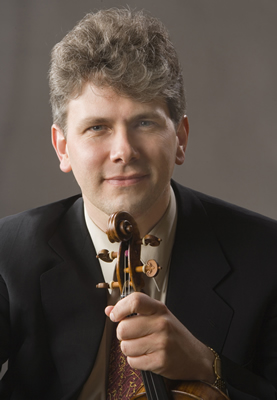St. Stephen’s Episcopal Church in Hope Valley, Durham, has a long tradition of fostering the arts. This concert, part of its annual series, presented an imaginative program of three major chamber works with piano by Felix Mendelssohn (1809-47). The performers were one half of the distinguished Borromeo Quartet, first violinist Nicholas Kitchen and his wife, cellist Yeesun Kim, with pianist Alexander Beyer, a very promising young talent. Nicholas is the son of Joseph and Dorothy Kitchen, both of whom have been long associated with both St. Stephen’s Church and with Duke University.
Mendelssohn’s Piano Trio No. 1 in D minor, Op. 49, is heard in performance more often than his second one because it bursts with very spontaneous-sounding melodies and the part-writing is lighter, because he was yet to be influenced by in-depth study of J.S. Bach’s contrapuntal style or his great choral works which Mendelssohn helped to revive. Both piano trios are in four movements. The first movement of the first one, Molto allegro ed agitato, is dominated by three themes. The cello opens singing a melancholy melody over rustling chords in the piano. The violin and piano take it in turn. Then the cello introduces an expansive, warm second theme. A third bold and swirling theme closes the movement. The piano part throughout the trio was extensively revised at the suggestion of Ferdinand Hiller to reflect the technical innovations of Liszt and Chopin. Flashy keyboard figurations give the work added brilliance. The Andante con molto tranquillo movement is like one of the composer’s Songs Without Words, tranquil with a stormy middle section. Mendelssohn is justly famous for his quicksilver, light “fairy music,” and this third movement, Scherzo: Leggiero e vivace, is one of his best. The Finale, Allegro assai appassionato, juxtaposes propulsive, rhythmic energy with soulful melodic episodes.
Kitchen, Kim, and Beyer played the socks off this effusive trio! Kim’s cello was so rich and warm sounding in the opening bars! Her phrasing brought out the song-like quality of much of Mendelssohn’s scoring. Kitchen brought a searing intensity to the violin part which was paired with precise intonation and equally effective phrasing. Both string players had superb palettes of color and dynamics. Beyer’s keyboard playing was a marvel of clarity, so beautifully articulated and perfectly balanced with the strings, despite having the piano’s lid fully up.
Mendelssohn’s Cello Sonata No. 2 in D, Op. 58, was composed in 1841 for Count Mateusz Wielhorski, an amateur who had virtuoso abilities. It is in four movements. The opening Allegro assai vivace is dominated by ever-surging melody from the cello supported by gossamer arpeggios and high chords from the piano. The Allegretto scherzando juxtaposes airy “fairy music” with a courtly melody. The Adagio opens with a chorale in dense, wide arpeggios from the piano followed by recitative-like musings from the cello. The concluding Moto allegro e vivace mixes a warm cello melody with a filigree accompaniment by the piano. A chorale-like passage in chords is a prominent feature.
Kim and Beyer turned in a superb performance. It was a rare treat to hear Kim’s cello in such a major, expansive role. Her instrument has a full, rich sound across its range. Her intonation and her stylish phrasing were marvelous. Her pizzicatos and her detailed articulation were superb. Beyer’s playing of the composer’s fleet, filigree-like parts was delightful as was his instant response to sudden changes in dynamics or tempo.
The concert ended with an intense, passionate performance of the Trio No. 2 in C minor, Op. 66. The opening Allegro energico e con fuoco is unified by an ascending and descending arpeggio which is treated to augmentation and diminution along with variations in dynamics and articulations. The second movement, Andante espressivo, is another Song Without Words with the piano and strings alternating the melody. The Scherzo: Molto allegro quasi presto is a headlong rush in which the three instruments chase each other. The opening of the Finale: Allegro appassionato is dominated by a dissonant leap of a ninth that begins on the upbeat of the cello’s phrase. The climax is reached when Mendelssohn introduces an original chorale-like melody in the piano. It resembles the well-known Lutheran chorale “Gelobet seist du, Jesu Christ” (Praise unto Thee, Jesus Christ). The elements are brought together and the trio ends as a glorious apotheosis.
All the virtues of the playing of Kitchen, Kim, and Beyer already mentioned were present in spades in Op. 66. The inspired intensity of the players swept the listener along on waves of melody. These artists ought to consider issuing this program on a compact disc.
St. Stephen’s Concert Series’ program notes, always interesting, are usually prepared by Joseph Kitchen. He deserves extra kudos for an extensive overview of Mendelssohn’s life and music and its suppression during the Nazi era. The extensive color illustrations were icing on the cake!











